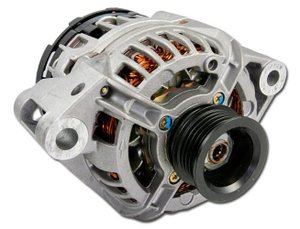Convert the Mechanical energy into the Electrical energy with the help of an Alternator!
Sounds simple?
Yes, it is.
The engine’s crankshaft generates energy to the pulley attached, which then provides energy to the engine, which transfers the energy to the car. The crankshaft pulley is responsible for transferring the spinning motion to other pulleys.
Our modern car has many pulleys attached to various accessories and components like the power steering pump, air conditioning compressor, water pump, alternator, and more. The alternator takes in the mechanical energy from these pulleys and turns it into electrical energy. This all seems simple but the internal working of an alternator is way more complex.
Working Inside the Alternator:
Just like a car, an alternator also has a pulley that is attached to its rotor. When the voltage is regulated through the wire coil present in the rotor, it produces a magnetic field. The act of a rotor spinning inside a set of stationery coils is called the stator. This rotating magnetic field then produces an alternate current in the given stationary coil.
But a car requires a direct current, not an alternating current. Thus, the alternator has a diode assembly, a rectifier, that converts the alternating current to direct current. This current can be used to provide power to run different car accessories and recharge the car’s battery.
This process is heavy for the alternator and so it gets heated. To cool it down, alternators have fans, to help the circulation of air.
Please note that we have eliminated a few steps and things to keep this explanation as simple as possible to understand.
An Alternator’s Purpose:
The alternator only had one job, to maintain a car’s battery charge. But why is it so important to have an alternator? It’s simple. When we use a car, we are not just driving, we use power windows, GPS navigation, Air conditioning, ignition, DVD player, and the like. But a car’s battery cannot provide so much energy directly. If the alternator was not present, the car’s battery would have been drained in a very short time, making your drive time very less, making it impossible to run without electricity. So to make the optimum use of the battery while maintaining its life, an alternator is used.
Limitations of an Alternator:
Alternators cannot recharge a dead or low battery.
Alternators are made to sustain the charge of the battery and cannot recharge a dead or low battery. The alternator sure has one job but it’s too much work and recharging a low battery or dead battery is just too much for an alternator to take.
Internal and External Fan Alternators:
The working principles of an alternator are still the same but the design has changed. This can be because our modern car requires more energy to run itself than our old car models. With an increase in the specifications of our car today, a simple or old alternator will not suffice the need. Due to this, the size of the alternators has also increased over time.
Still, there are companies like Lucas TVS that have their Lucas TVS alternators, which are still compact and have a longer time span. This is possible as they have,
- Changed the fan design for better cooling
- Changes the designs of the rectifier and the regulator, to increase their durability
- Having more wires to fit in the alternators by redesigning the stator
Modern alternators in our car use 2 internal fans. These fans keep the alternator very cool. The fans are attached to the rotor. Also, our new and improved alternative has spinners that spin at a higher speed. This increases the overall output as more air in the alternator can make it cool faster, indeed making it perform more efficiently.
Is your alternator broken? Replace it with the original company-authorised alternator, Lucas TVS, available at Krishna Auto Electric. Contact us now for an instant quote!
